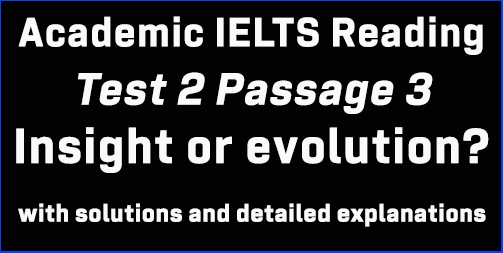IELTS Academic Reading: Cambridge Official Guide to IELTS Test 2 Reading passage 2; Dawn of the robots; with best solutions and best explanations
This Academic IELTS Reading post focuses on solutions to IELTS Cambridge Official Guide to IELTS Test 2 Reading Passage 2 which is titled ‘Dawn of the robots’. This is a targeted post for IELTS candidates who have big problems finding out and understanding Reading Answers in the AC module. This post can guide you the best to understand every Reading answer without much trouble. Finding out IELTS Reading answers is a steady process, and this post will assist you in this respect.
Cambridge Official Guide to IELTS Test 2: AC Reading Module
Reading Passage 2: Questions 14-26
The headline of the passage: Dawn of the robots
Questions 14-19: List of headings
[In this question type, IELTS candidates are provided with a list of headings, usually identified with lower-case Roman numerals (i, ii, iii, etc,). A heading will refer to the main idea of the paragraph or section of the text. Candidates must find out the equivalent heading to the correct paragraphs or sections, which are marked with alphabets A, B, C and so forth. Candidates need to write the appropriate Roman numerals in the boxes on their answer sheets. There will always be two or three more headings than there are paragraphs or sections. So, some of the headings will not be used. It is also likely that some paragraphs or sections may not be included in the task. Generally, the first paragraph is an example paragraph that will be done for the candidates for their understanding of the task.
Question no. 14: Paragraph A
The writer describes a road accident in the first part of the paragraph. Then, in lines 6-8, the writer says, “ . . .. Normally, drivers get out, gesticulate, exchange insurance details and then drive off. But not on this occasion. No one got out of the cars for the simple reason that they had no humans inside them; . .. ..”
Here, But not on this occasion = Not what it seems to be,
So, the answer is: v (Not what it seems to be)
Question no. 15: Paragraph B
To find the answer to this question, we have to read the first lines and the final lines of paragraph B.
First, let’s have a look at the beginning, where the writer says, “The idea that machines could perform to such standards is startling. .. .”
Here, machines could perform to such standards = the performance of robots, startling = astonishing or amazing,
This means the performance of the robots was astonishing.
Then, in lines 11-14, the writer says, “ . . .. Yet only three years earlier, at DARPA’s previous driverless car race, every robot competitor – directed to navigate across a stretch of open desert – either crashed or seized up before getting near the finishing line.”
Here, only three years earlier = last time,
These lines suggest that the robots could not perform well three years earlier at DARPA’s previous driverless car race.
This means there was a significant improvement on last time (three years earlier).
So, the answer is: ii (A significant improvement on last time)
Question no. 16: Paragraph C
Paragraph C contains the opinion of Bill Gates. Take a look at lines 4-6, “ . .. . – a point stressed by Bill Gates, the Microsoft boss who is a convert to these causes. ‘The robotics industry is developing in much the same way the computer business did 30 years ago,’ he argues. . .. .”
Here, in much the same way = following the pattern, developing .. .. . the computer business did 30 years ago = earlier development,
So, the answer is: viii (Following the pattern of an earlier development)
Question no. 17: Paragraph D
The last few lines of paragraph D say, “ . .. . Humans orient themselves with other objects in a room very easily. Robots find the task almost impossible. ‘Even something as simple as telling the difference between an open door and a window can be tricky for a robot,’ says Gates. This has, until recently, reduced robots to fairly static and cumbersome roles.”
Here, fairly static and cumbersome roles = roots rarely move, Robots find the task almost impossible = the reason why robots move rarely,
So, the answer is: vii (The reason why robots rarely move)
Question no. 18: Paragraph E
Lines 1-4 of paragraph E say, “For a long time, researchers tried to get round the problem by attempting to re-create the visual processing that goes on in the human cortex. However, that challenge has proved to be singularly exacting and complex. So scientists have turned to simpler alternatives. . . … .”
Here, scientists have turned to simpler alternatives = tackling the issue using a different approach,
So, the answer is: i (Tackling the issue using a different approach)
Question no. 19: Paragraph F
At the beginning of paragraph F, in lines 1-4, the writer gives an example of robots at work in restaurants, “Last year a new Hong Kong restaurant, Robot Kitchen, opened with a couple of sensor-laden, humanoid machines directing customers to their seats. Each possesses a touch-screen on which orders can be keyed in. The robot then returns with the correct dishes. . .. .”
Then, in lines 4-6, the author presents another example, “ .. .. . In Japan, University of Tokyo researchers recently unveiled a kitchen ‘android’ that could wash dishes, pour tea and make a few limited meals. . .. .”
So, the answer is: iv (examples of robots at work)
Questions 20-23: Matching statements with list of people
[In this type of question, candidates need to relate statements that are given by or link to people in the passage. The rules for finding answers to this sort of question are simple. Just find the name of the person and read around it carefully. Then, give a quick look to check whether there is another statement or idea provided by the same person in the text. If there is, check the reference carefully and decide your answer. Remember, the questions may not follow any sequential order.]
Question no. 20: An important concern for scientists is to ensure that robots do not seem frightening.
Keywords for the question: important concern for scientists, ensure, robots, do not seem, frightening,
In the final paragraph (Paragraph F), have a look at the final lines, “ .. . . Machines such as these take researchers into the field of socialised robotics: how to make robots act in a way that does not scare or offend individuals. ‘We need to study how robots should approach people, how they should appear. That is going to be a key area for future research,’ adds Chrisley.”
Here, how to make robots act in a way that does not scare or offend individuals = ensure that robots do not seem frightening,
So, the answer is: C (Ron Chrisley)
Question no. 21: We have stopped trying to enable robots to perceive objects as humans do.
Keywords for the question: stopped, trying to enable, robots, perceive, objects, as humans do,
The answer can be found in lines 4-9 of paragraph E, “ .. .. ‘We have become far more pragmatic in our work,’ says Nello Cristianini, Professor of Artificial Intelligence at the University of Bristol in England and associate editor of the Journal of Artificial Intelligence Research. ‘We are no longer trying to re-create human functions. Instead, we are looking for simpler solutions with basic electronic sensors, for example.’ . .. .”
Here, We are no longer trying = We have stopped trying, to re-create human functions = to enable robots to perceive objects as humans do,
So, the answer is: B (Nello Cristianini)
Question no. 22: It will take considerable time for modern robots to match the ones we have created in films and books.
Keywords for the question: will take considerable time, modern robots, to match the ones, films and books,
In the first few lines of Paragraph D, the writer says, “What is the potential for robots and computers in the year future? ‘The fact is we still have a way to go before real robots catch up with their science fiction counterparts,’ Gates says. . .. .”
Here, we still have a way to go = It will take considerable time, real robots = modern robots, catch up with = to match, their science fiction counterparts = the ones we have created in films and books,
So, the answer is: A (Bill Gates)
Question no. 23: We need to enable robots to move freely before we think about trying to communicate with them.
Keywords for the question: need to enable robots, move freely, before, think, trying to communicate, with them,
In paragraph F, take a close look at lines 10-12, “ . .. . . . ‘Robots first learn basic competence – how to move around a house without bumping into things. Then we can think about teaching them how to interact with humans,’ Chrisley said. . … .”
Here, how to move around a house = how to move, without bumping into things = freely, how to interact with humans = to communicate with them,
So, the answer is: C (Ron Chrisley)
Questions 24-26: Completing notes
[In this type of question, candidates are asked to complete different notes with NO MORE THAN TWO WORDS from the passage. Keywords are important to find answers correctly. Generally, this type of question maintains a sequence. However, we should not be surprised if the sequence is not maintained. Find the keywords in the passage and you are most likely to find the answers.]
Title of the notes: Robot features
Question no. 24:
DARPA race cars: ________ provides maps and plans for route
Keywords for the question: DARPA race cars, provides, maps and plans, routes,
We find about DARPA Car race in the end of Paragraph A.
Then, at the beginning of paragraph B, the author of the text says, “The idea that machines could perform to such standards is startling. Driving is a complex task that takes humans a long time to perfect. Yet here, each car had its on-board computer loaded with a digital map and route plans, and was instructed to negotiate busy roads. .. ..”
Here, each car = DARPA race car, a digital map and route plans = maps and plans for route,
So, the answer is: on-board computer / onboard computer
Question no. 25:
Electrolux Trilobite: builds an image of a room by sending out ________
Keywords for the question: Electrolux Trilobite, builds, image of a room, by sending out,
The reference to Electrolux Trilobite can be found in paragraph E. Here, lines 10-12 say, “ . . .. The Trilobite scuttles around homes emitting ultrasound signals to create maps of rooms, which are remembered for future cleaning. .. .”
Here, The Trilobite = Electrolux Trilobite, create maps of rooms = builds an image of a room, emitting = sending out,
So, the answer is: ultrasound signals
Question no. 26:
Robot Kitchen humanoids: have a _______ to take orders
Keywords for the question: Robot Kitchen humanoids, have, to take orders,
The answers to these questions can be found in paragraph F. Here, the writer says at the beginning, “Last year, a new Hong Kong restaurant, Robot Kitchen, opened with a couple of sensor-laden, humanoid machines directing customers to their seats. Each possesses a touch-screen on which orders can be keyed in. .. . .”
Here, humanoid machines = humanoids, possesses = have,
So, the answer is: touch-screen / touchscreen
Click here for solutions to Cambridge IELTS Official Test 2 Reading Passage 1
Click here for solutions to Cambridge IELTS Official Test 2 Reading Passage 3




Please inform us of this passage from which Cambridge book?